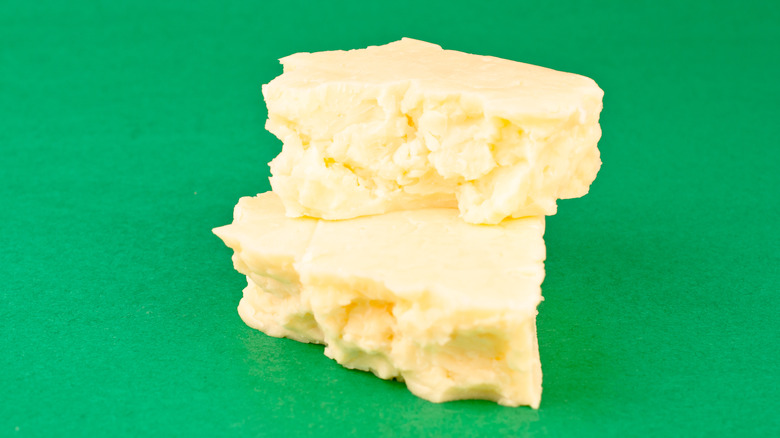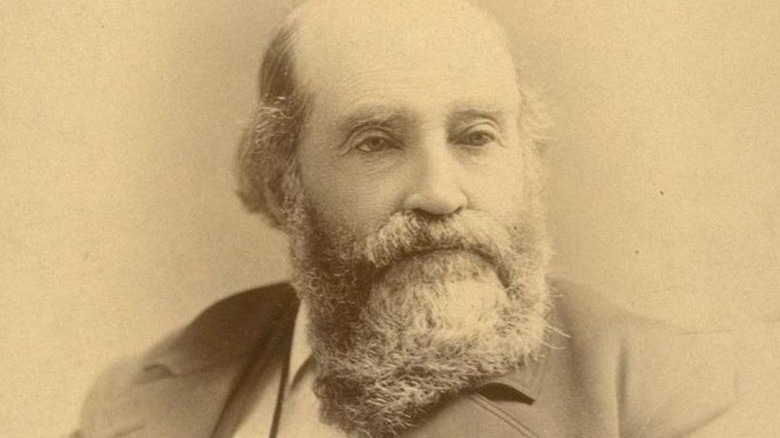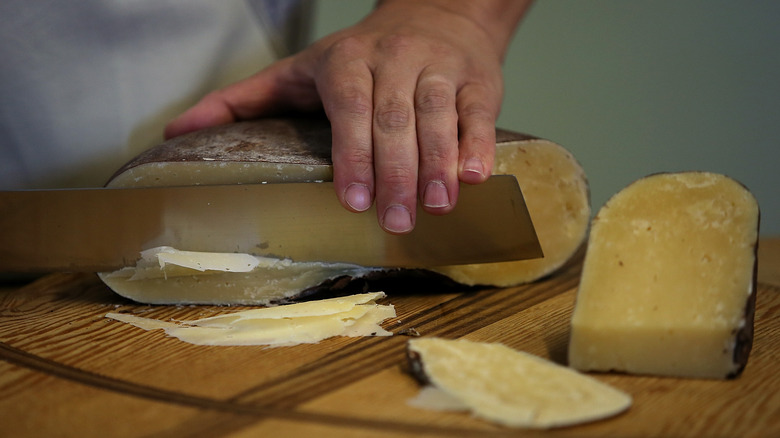The Twisted Origin Story Behind Monterey Jack Cheese
At first glance, Monterey Jack seems like a fairly simple, straightforward cheese. As explained by Encyclopedia Britannica, its flavor profile can be described as smooth, mild, or bland, depending on how positive or negative you wish to be. While randomly distributed holes give the cheese's appearance some texture, the pale ivory color doesn't exactly catch the eye. Usually, the cow's-milk base is aged for a handful of weeks, making this cheese relatively quick and easy to produce. Yet, occasionally, cheesemakers age it for a couple of months or add ingredients like peppers or spices to give it that extra oomph. Dry Jack, a variation of this cheese, is aged for even longer in order to give it a rich flavor and an impressive mouthfeel similar to that of aged cheddar.
None of this is to say the common Monterey Jack cheese is bad! As noted by Wisconsin Cheese, this variety is great for melting, thanks to its moisture and fattiness. So, Monterey Jack is often included in dishes like dips, grilled cheese, mac 'n cheese, pasta casseroles, quesadillas, and soups. This is especially true for Tex-Mex and Mexican cuisine. Add some leek, lemon, pesto, or whatever else you want, and this cheese becomes quite a mouthful. For those who like to drink while things get cheesy, this buttery item pairs well with lighter beers (brown ale, IPA, pilsner) and wines (chardonnay, Riesling, sparkling), as well as stronger stuff like bourbon. The true complexity in Monterey Jack cheese, though, comes from its backstory.
David Jacks popularized the cheese in Monterey
The history of Monterey Jack is not quite as upbeat as the origins of some other cheeses, like ancient France's Muenster cheese. As explained by Encyclopedia Britannica, the consensus is that Monterey Jack fittingly came from Monterey County, California. There, Wisconsin Cheese notes 18th-century friars invented the product before a businessman named David Jacks (originally named David Jack) got his hands on the stuff and then championed it commercially. Yet, in order to do this, Jacks essentially stole the recipe.
Back in the 1700s, Spanish missionaries set up shop in places like modern San Diego and Monterey Bay, per Food & Wine. These missions brought cattle, which produced milk that later turned into queso blanco país. In 1848, the U.S. purchased California from Mexico, and Americans rushed in to manifest their destiny. Many of the Mexican farmers who stayed were soon cheated out of their land. (It's worth noting indigenous peoples inhabited California for tens of thousands of years before Spanish missionaries ever arrived, per History). This set the stage for a New Yorker, David Jacks, to profit immensely.
According to Food & Wine, Jacks swooped in on a hastily put-together land auction and bought up most of Monterey City. Having become a landlord, he used tax hikes and language barriers to his advantage, foreclosing upon countless properties. In the process, Jacks took possession of many dairy farm properties, including queso blanco país. He then sold it, renaming it "Jack's Cheese," which caught on statewide as "Monterey Jack's cheese."
The history of Monterey Jack is still debated
It's generally accepted that Jacks was the (arguably evil) mastermind behind Monterey Jack cheese's rise to fame. However, there are a few details still debated and even a competing theory or two floating around, too. KQED echoes Food & Wine's account of Jacks, but also digs into the specifics of where particularly he found this cheese recipe.
The inspiration for Monterey Jack cheese may have come from Italian immigrant Stephano Mori in the Californian city of Pacifica, per KQED. A family friend apparently learned his Italian cheese recipe and brought it to a ranch in Monterey, where it became Jacks'. Others look to Carmel Valley, California, where Domingo Pedrazzi made "jack cheese" with a jack press that removed moisture from the product. Another story claims a Monterey woman recreated the Spanish missionaries' European cheese and sold it door-to-door until Jacks took notice. In the end, it all culminates with him.
Jacks ensured that, whatever the truth is, his name and Monterey's would forever be remembered through "his" cheese. Despite this, as recently as 2019, Atlas Obscura reported there were only a couple of dairy farms left in the region; Monterey is now part of America's "Salad Bowl," where lettuce and fruits are the agricultural focus. Places like Sonoma County, California, and Wisconsin are Monterey Jack's current cheesemakers. Nonetheless, some things never change — Monterey Jack is delicious and beloved; according to YouGov America, this cheese is a top-five favorite in the United States.


